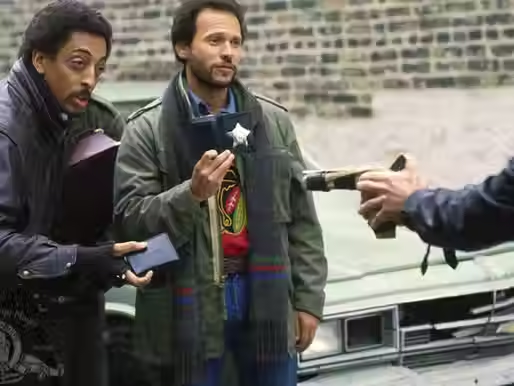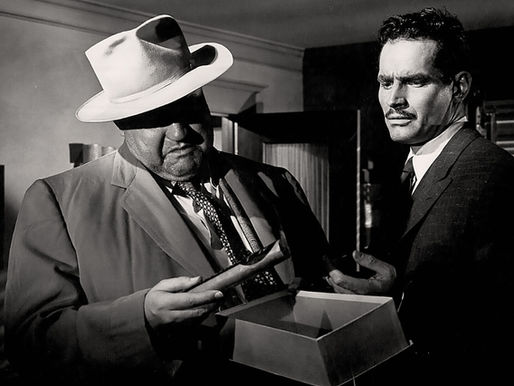top of page
Search
Film Reviews
Reviews of films from 1930's through to 1999.


The Silver Chalice (1954)
The Silver Chalice (1954) was part of Hollywood’s mid-20th-century boom in religious and historical epics, released amid the popularity of grand Technicolor spectacles such as Quo Vadis (1951), The Robe (1953), and Ben-Hur (1959).

Soames Inscker
4 min read


Show Boat (1936)
The 1936 version of Show Boat is widely regarded as the definitive screen adaptation of the seminal 1927 Broadway musical. A heartfelt and, at times, harrowing portrayal of race, love, loss, and resilience along the Mississippi River, the film is a triumph of performance, music, and direction.

Soames Inscker
5 min read


Spellbound (1945)
Spellbound is Alfred Hitchcock’s first major foray into psychoanalysis as a thematic and narrative device. Adapted from the novel The House of Dr. Edwardes by Hilary Saint George Saunders and John Palmer, it follows a psychiatrist (Ingrid Bergman) who must unravel the mystery behind a man (Gregory Peck) claiming to be the new director of a mental hospital—only to discover he may be an impostor and murderer suffering from amnesia.

Soames Inscker
4 min read


The Cockleshell Heroes (1955)
The Cockleshell Heroes is a compelling British war film based on the real-life Operation Frankton, a daring 1942 British Royal Marines raid on German shipping in the port of Bordeaux. Directed by and starring José Ferrer, the film was a rare attempt in the 1950s to dramatize British military heroism with an American-Hollywood sensibility while retaining a fundamentally British tone.

Soames Inscker
4 min read


Running Scared (1986)
Released in 1986, Running Scared is a quintessential 1980s buddy-cop action-comedy that blends sharp dialogue, charismatic leads, and brisk pacing with an emotional core that's rare for the genre. Directed by Peter Hyams (Capricorn One, 2010), the film pairs Billy Crystal and Gregory Hines as two wisecracking Chicago cops on the brink of retirement who are forced back into action when a drug lord they've been chasing resurfaces.

Soames Inscker
4 min read


M (1931)
Fritz Lang’s M (1931) is widely regarded as one of the greatest and most influential films ever made. A chilling hybrid of crime thriller, social drama, and proto-noir, it was Lang’s first sound film and remains his masterpiece.

Soames Inscker
5 min read


Touch of Evil (1958)
Orson Welles’s Touch of Evil (1958) is widely regarded as the last true film noir of Hollywood’s classic era—and arguably one of the greatest. It’s a feverish, atmospheric, and at times grotesque crime drama, brimming with visual invention and moral ambiguity. Made on a modest budget and dismissed by its studio, the film was re-edited and truncated before its release, only to be rediscovered and reappraised decades later.

Soames Inscker
5 min read


Kiss Me Deadly (1955)
Robert Aldrich’s Kiss Me Deadly (1955) is a brutal, nightmarish film noir that shattered the conventions of its genre while also providing a deeply cynical, subversive reflection of Cold War-era America. Ostensibly based on Mickey Spillane’s pulp novel, the film uses the basic framework of a detective thriller to launch an assault on traditional morality, masculinity, and the very concept of heroism.

Soames Inscker
5 min read


The Manchurian Candidate (1962)
John Frankenheimer’s The Manchurian Candidate (1962) is a chilling political thriller that remains as provocative and powerful today as it was during the height of the Cold War. Based on Richard Condon’s 1959 novel, the film is a masterful blend of psychological drama, paranoid satire, and social commentary—a heady cocktail of suspense and surrealism that explores themes of brainwashing, McCarthyism, authoritarianism, and maternal domination.

Soames Inscker
5 min read


The Killing (1956)
Stanley Kubrick’s The Killing (1956) is widely considered one of the most influential crime films of its era—and justly so. A taut, razor-sharp noir thriller that crackles with intensity and precision, it marked Kubrick’s first mature work and set the tone for his meticulous, often clinical approach to storytelling. Adapted from Lionel White’s novel Clean Break, The Killing is both a triumph of narrative innovation and an exemplary piece of low-budget filmmaking that has cast

Soames Inscker
4 min read


Blow Up (1966)
Michelangelo Antonioni’s Blow-Up (1966) is a landmark of 1960s cinema—a work that simultaneously captures the cultural and aesthetic energy of Swinging London and interrogates the very nature of reality, perception, and meaning. It was Antonioni’s first English-language film, and perhaps his most internationally influential, earning the Palme d’Or at Cannes and launching a new era of art cinema into the mainstream.

Soames Inscker
5 min read


The Vanishing (1988)
The Vanishing (Spoorloos, 1988), directed by George Sluizer, is a psychological thriller that unnerves not through action or gore, but through its cold, clinical exploration of obsession, evil, and the terrifying ambiguity of disappearance. A Dutch-French production based on the novella The Golden Egg by Tim Krabbé, the film is a stark, tightly wound meditation on the unknown—and on the monstrous banality of evil.

Soames Inscker
5 min read


The Night of the Hunter (1955)
The Night of the Hunter (1955) stands as one of the most haunting and visually poetic films in American cinema. Directed by the legendary actor Charles Laughton in his only directorial effort, it is a singular, uncompromising work—a gothic fairy tale wrapped in an expressionist nightmare, blending childhood innocence with pure evil.

Soames Inscker
5 min read


The Long Goodbye (1973)
Robert Altman’s The Long Goodbye (1973) is less a traditional adaptation of Raymond Chandler’s 1953 detective novel than a postmodern riff on it—a revisionist noir, a sun-drenched elegy for the hardboiled genre, and a sly, satirical portrait of 1970s Los Angeles in moral and cultural freefall.

Soames Inscker
5 min read


Point Blank (1967)
Point Blank (1967) is a film of shattered time, splintered identity, and existential revenge. Directed by the visionary John Boorman in his first American production, it takes the skeletal framework of a pulp crime thriller and transforms it into a hypnotic, existential, and almost surrealist neo-noir.

Soames Inscker
5 min read


Elevator to the Gallows (1958)
Louis Malle’s Elevator to the Gallows (Ascenseur pour l’échafaud) is a landmark of postwar French cinema—a taut, stylish thriller that bridges the fatalism of American film noir with the existential anxiety and aesthetic innovation of the French New Wave. Released in 1958, when Malle was only 24 years old, the film marked both his feature debut and the beginning of a long, varied, and daring directorial career.

Soames Inscker
5 min read


Shadow of Doubt (1943)
Shadow of a Doubt (1943) is often described by Alfred Hitchcock himself as his personal favourite among all his films—and with good reason. In many ways, it’s one of his most psychologically disturbing works, despite lacking the overt violence or technical bravura of his later classics. This slow-burning thriller unfolds in broad daylight, on the sunny porches and quiet streets of small-town America, making its themes of corruption, duality, and evil all the more unsettling.

Soames Inscker
5 min read


Blood Simple (1984)
Blood Simple (1984) is a film that feels at once timeless and radical. As the feature debut of Joel and Ethan Coen, it is a genre-defining work that would become the foundation for one of the most distinctive and influential filmographies in American cinema.

Soames Inscker
5 min read


Knife in the Water (1962)
Roman Polanski’s Knife in the Water (Nóż w wodzie, 1962) is a taut, minimalist psychological thriller that marks one of the most assured debuts in the history of cinema. Released during the height of the Polish Film School movement, it broke with the dominant trend of war and historical themes to focus instead on contemporary tensions and the theater of interpersonal conflict.

Soames Inscker
4 min read


Blow Out (1981)
Brian De Palma’s Blow Out (1981) is a gripping political thriller that doubles as an intricate meditation on perception, media manipulation, and the existential weight of truth. Both an homage to Michelangelo Antonioni’s Blow-Up (1966) and Francis Ford Coppola’s The Conversation (1974), Blow Out finds its own voice through De Palma’s signature stylistic bravado, razor-sharp editing, and a surprisingly powerful performance by John Travolta.

Soames Inscker
4 min read
bottom of page


